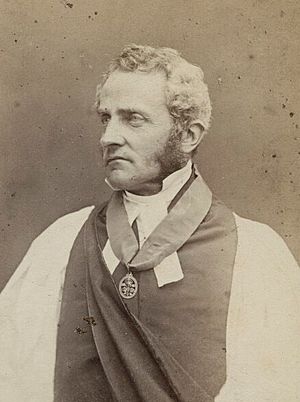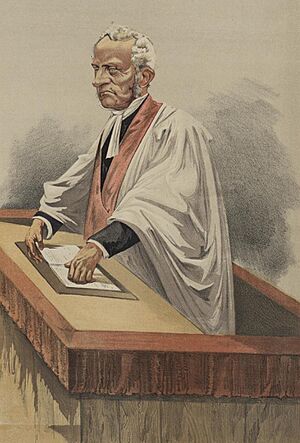Arthur Penrhyn Stanley facts for kids
Quick facts for kids The Very Reverend Arthur Penrhyn Stanley FRS |
|
|---|---|
| Dean of Westminster | |
 |
|
| Church | Church of England |
| See | Royal Peculiar |
| In Office | 1864 to 1881 |
| Predecessor | Richard Chenevix Trench |
| Successor | George Granville Bradley |
| Other posts | Regius Professor of Ecclesiastical History (1856–1863) Rector of the University of St Andrews (1874–1877) |
| Personal details | |
| Birth name | Arthur Penrhyn Stanley |
| Born | 13 December 1815 Alderley Edge, Cheshire, England |
| Died | 18 July 1881 (aged 65) London, England |
| Denomination | Anglicanism |
| Education | Rugby School |
| Alma mater | Balliol College, Oxford |
| Signature |  |
Arthur Penrhyn Stanley (13 December 1815 – 18 July 1881) was a famous English Anglican priest and a historian of the church. He was often known as Dean Stanley. From 1864 to 1881, he served as the Dean of Westminster, which is a very important role at Westminster Abbey. He believed in a "Broad Church" approach, meaning he wanted the church to be more open and accepting of different ideas. He also wrote many books about the history of Christianity and helped start the Palestine Exploration Fund.
Contents
Early Life and Education
Arthur Penrhyn Stanley was born in Alderley Edge, a town in Cheshire, England. His father, Edward Stanley, later became the Bishop of Norwich. Arthur went to Rugby School, a well-known boarding school, where he was taught by Thomas Arnold. He is thought to be the inspiration for the character George Arthur in the famous book Tom Brown's Schooldays.
In 1834, he went to Balliol College, Oxford, one of the colleges at Oxford University. He was a very good student, winning important scholarships and prizes. After finishing his studies, he became a Fellow at University College and was ordained as a priest in 1839.
He traveled to Greece and Italy in 1840. When he returned, he became a tutor at Oxford. He was very popular with his students and made many friends. His first famous book, Life of Arnold, about his old headmaster, was published in 1844. He also wrote Sermons and Essays on the Apostolic Age, which showed his ideas about theology. He believed in being open-minded and tolerant in religious discussions.
Working for University Reform
Stanley was keen on making universities better and more modern. He worked as a secretary for a special group set up in 1850 to look into university reform. He played a big part in writing a report in 1852 that suggested important changes. These changes included making it easier for students to get scholarships and fellowships, and allowing more people to have a say in how the university was run.
Before this report came out, Stanley was appointed to a special position at Canterbury Cathedral. While there, he wrote a book about his father in 1851. He also completed his Commentary on the Epistles to the Corinthians in 1855.
In 1852-1853, he traveled to Egypt and the Holy Land. This trip led to his well-known book, Sinai and Palestine (1856). He also visited Russia in 1857, gathering information for his book Lectures on the Eastern Orthodox Church (1861). His book Memorials of Canterbury (1855) showed his skill in writing about history.
Professor and Dean
In 1856, Stanley became the Regius Professor of Ecclesiastical History at Oxford. This meant he taught about the history of the church. He started his history with the story of Abraham and published the first two parts of his History of the Jewish Church in 1863 and 1865.
He was involved in some big debates in the church during the 1860s. He believed in making the rules for priests less strict. In 1865, a law was passed that made some of his ideas happen. In 1862, Queen Victoria asked Stanley to go with the Prince of Wales (who later became Edward VII) on a trip to Egypt and Palestine. The Queen also made him Deputy Clerk of the Closet in 1863.
In 1863, Stanley was considered for the role of Archbishop of Dublin, but he wasn't chosen. Instead, he was appointed Dean of Westminster at Westminster Abbey later that year. In December 1863, he married Lady Augusta Bruce.
Dean of Westminster Abbey

As Dean of Westminster, Stanley worked hard to protect and care for the many historical monuments in Westminster Abbey. He published his Memorials of Westminster Abbey in 1865, which is full of interesting facts about the Abbey. He was a regular preacher there and invited other famous preachers to speak.
His move to London made him even more influential. He had friends from all walks of life and from many different countries.
His Writings and Beliefs
Stanley was always writing. He produced many articles, lectures, and sermons. He also wrote the third volume of his History of the Jewish Church, a book about the Church of Scotland, and Addresses and Sermons preached in America. His books Essays Chiefly on Questions of Church and State (1870) and Christian Institutions: Essays on Ecclesiastical Subjects (1881) are still important today.
He often took part in religious discussions, always politely. He stood up for people he thought were being treated unfairly, even if he didn't fully agree with them. For example, he defended Bishop Colenso. He also invited people from different Christian groups, including a Unitarian, to take Holy Communion at the Abbey. This caused some strong feelings among more traditional church members. He also tried to make it optional to say the Athanasian Creed in the Church of England.
In 1874, he visited Russia to attend the wedding of Alfred, Duke of Edinburgh and the Grand Duchess Marie.
Final Years and Legacy
Stanley's wife passed away in 1876, which was a very sad time for him. In 1878, he toured America and later visited Italy and Venice for the last time. In 1881, he gave funeral sermons for famous people like Thomas Carlyle and Benjamin Disraeli at the Abbey.
He died at the Deanery on 18 July 1881.
Arthur Penrhyn Stanley was buried in Henry VII's chapel in Westminster Abbey, next to his wife. Many important people attended his funeral, including members of the Royal Family, politicians, writers, scientists, and religious leaders. A monument by Sir Joseph Edgar Boehm was placed on his grave, and windows in the Abbey were dedicated to his memory, one given by Queen Victoria herself.
Stanley was a leading liberal theologian of his time. He believed that the Christian Church needed to change and become more open. He thought that the church should focus on the main moral and spiritual truths taught by Christ, rather than on small details or old arguments. He also believed that the church and state should work together. He wanted the church to be as welcoming as possible, even suggesting that non-Anglican preachers should be allowed to speak in Anglican churches.
His ideas about focusing on the core teachings of Christianity and being more inclusive have had a lasting impact on the Church of England.
Works
- Life of Doctor Arnold (1844)
- Sermons and Essays on the Apostolic Age (1847)
- Memoir of his father (1851)
- Commentary on the Epistles to the Corinthians (1855)
- Historical Memorials of Canterbury (1855)
- Sinai and Palestine in Connexion with their History (1856)
- History of the Eastern Church (1861)
- History of the Jewish Church (3 volumes, 1863, 1865, 1870)
- Historical Memorials of Westminster Abbey (1870)
- Essays on Church and State (1870)
- The Church of Scotland (1870)
- Addresses and Sermons preached in America (1870)
- Essays Chiefly on Questions of Church and State from 1850 to 1870 (1870)
- Christian Institutions: Essays on Ecclesiastical Subjects (1881)



